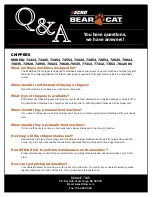
JOHNSON CONTROLS
71
FORM 160.81-NOM1
ISSUE DATE: 10/3/2020
6
SECTION 6 – TROUBLESHOOTING
TROUBLESHOOTING GUIDE
Successful problem solving requires an organized ap-
proach to define the problem, identify the cause, and
make the proper correction. Sometimes it is possible
that two relatively obvious problems combine to pro-
vide a set of symptoms that can mislead the trouble-
shooter. Be aware of this possibility and avoid solving
the “wrong problem”.
ABNORMAL OPERATION, ANALYSIS AND
CORRECTION
Four logical steps are required to analyze an operational
problem effectively and make the necessary corrections:
1.
Define the problem and its limits.
2. Identify all possible causes.
3. Test each cause until the source of the problem is
found.
4. Make the necessary corrections.
When an operating problem develops, compare all op-
erating information on the OPERATING DISPLAY
with normal operating conditions. If an Operating Log
has been maintained, the log can help determine what
constitutes normal operation for the compressor unit in
that particular system.
TROUBLESHOOTING THE ROTARY SCREW
COMPRESSOR AND OIL SEPARATION
SYSTEM
Troubleshooting the compressor is limited to identify-
ing the probable cause. If a mechanical problem is sus-
pected contact the Johnson Controls Service Depart-
ment. DO NOT DISASSEMBLE COMPRESSOR.
TABLE 18 -
TROUBLESHOOTING
TROUBLESHOOTING THE ROTARY SCREW COMPRESSOR
SYMPTOM
PROBABLE CAUSES AND CORRECTIONS
Excessive Noise And Vibration
Bearing damage or excessive wear.
Refrigerant flood back. Correct system problem.
Chiller installation.
Room acoustics.
Piping supports.
Slide Valve Will Not Move
Slide valve stuck.
Capacity control block solenoid not energized.
Capacity control block services valves not opened.
Plugged orifi
ces on capacity control block.
TROUBLESHOOTING THE OIL SEPARATION SYSTEM
SYMPTOM
PROBABLE CAUSES AND CORRECTIONS
Gradual Oil Loss With An Oil Level In The
Separator Section Sight Glass
Maintaining too high an oil level, lower level.
Refrigerant carryover or liquid injection overfeeding, correct operation.
Loss of suction superheat
OPERATING ANALYSIS CHART
RESULTS
POSSIBLE CAUSE
REMEDY
1. SYMPTOM: ABNORMALLY HIGH DISCHARGE PRESSURE
Temperature difference between liquid
refrigerant temperature and water off
condenser higher than normal.
Air in condenser.
Purge unit.
High discharge pressure.
Condenser tubes dirty or
scaled.
Clean condenser tubes. Check water
conditioning.
High condenser water
temperature.
Reduce condenser water inlet temperature.
(Check cooling tower and water circulation.)
Temperature difference between condenser
water on and water off higher than normal,
with normal evaporator pressure.
Insufficient condensing water
flow.
Increase the quantity of water through the
condenser to proper value.






































